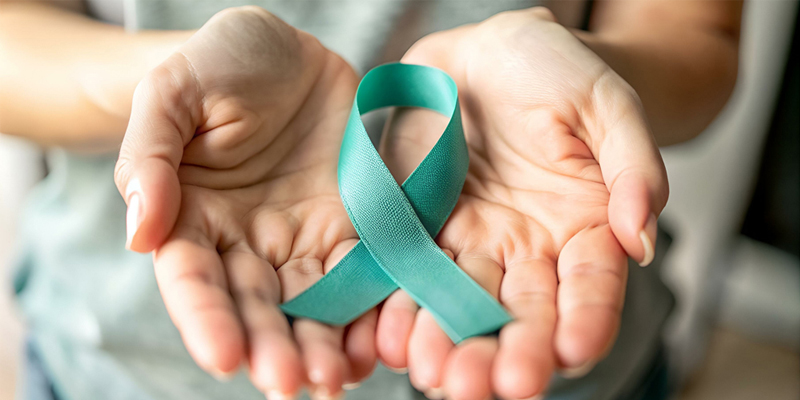Finding Ways to Detect Ovarian Cancer

Today is World Ovarian Cancer Day. Each year on this day, women living with ovarian cancer, their families and supporters, along with patient advocacy organisations from around the world, come together to raise awareness about ovarian cancer.
Researchers in the School of Biochemistry & Cell Biology are working on finding better ways of studying and detecting ovarian cancer. Here, Dr Kellie Dean speaks about their ongoing research in this area.
What does your research focus on?
Our research on ovarian cancer focuses on finding better ways to study it and catch it early. All aspects of this research are guided by our patient partners – individuals directly affected by ovarian cancer. They bring invaluable perspectives, helping us ensure that our work is focused on what matters most to patients.
Ovarian cancer is an incredibly complex disease that is hard to detect early. There is no early detection test for ovarian cancer. Up to 60% of cases are diagnosed at a later stage. This means that most cases are diagnosed at an advanced stage, when treatments are less effective. As well as this, ovarian cancer has historically been underfunded and under-researched compared to other cancers. By focusing on this disease, we’re advocating for women’s health and ensuring that ovarian cancer gets the attention it deserves in medical research.
Additionally, ovarian cancer is not just one disease – it consists of several subtypes, each with unique features and different responses to treatment. Despite this, traditional approaches often treat all ovarian cancer patients the same, leading to suboptimal outcomes for many. Researching this area while keeping the complexity of ovarian cancer in mind can help us to develop more personalized, precise therapies that better address individual needs.
What are the signs and symptoms of ovarian cancer that women should be aware of?
Everyone should know the ‘BEAT’ symptoms of ovarian cancer. B is for persistent bloating, E is for eating less and feeling fuller, A is for abdominal pain and T is for toilet changes in urination or bowel habits. These things happen normally from time to time, but if any one of them persists over two or three weeks, then get it checked out.
What does your research involve?
One significant part of our research focuses on helping scientists choose the best cell lines for studying ovarian cancer. Cell lines are cells originally taken from tumours that are grown in the lab to study the disease or test new drugs and treatments. Our research matches cell lines commonly used in labs with real patient tumours by comparing their molecular data – essentially looking at which parts of their DNA are switched on or off. By identifying the cell lines most like ovarian tumours, we aim to guide other scientists toward using the most accurate models for their experiments. This could lead to better similarity between what we do in the laboratory and what can be applied in the clinic, like developing new treatments or diagnostic methods.
Additionally, we’re working on identifying biomarkers - molecules that could indicate whether someone has ovarian cancer. These biomarkers could eventually be used to make early diagnosis, when the disease is more treatable, a reality.
What is the potential impact of your work?
Our work provides scientists with the tools to select the most suitable cell lines for their studies. We hope to improve the accuracy and relevance of research, making lab findings more applicable in real-world clinical settings. We’re also committed to discovering biomarkers that could enable early diagnosis, giving patients the best chance for successful treatments. At the heart of our work is the patient voice. By involving patient partners, we’re ensuring that their priorities and real-world experiences are central to our research efforts.
What have been your key findings?
The more we learn about this complex disease, the closer we come to developing effective treatments and early diagnostic tools. Some of our key findings include:
- Identifying the best cell lines: We have determined which cell lines are most suitable for studying specific subtypes of ovarian cancer. Using these models can improve the success of clinical trials and help advance treatments faster.
- Re-evaluating popular cell lines: We uncovered that one of the most widely used cell lines in ovarian cancer research might not actually originate from ovarian cancer. This finding underscores the importance of reassessing research models to ensure that they best reflect what is happening in patients.
- Discovery of potential biomarkers: We identified several long non-coding RNAs (lncRNAs) that could serve as biomarkers for early detection of ovarian cancer. These are currently being tested further in the laboratory.
- Highlighting the value of patient involvement: Collaborating with patient partners has been transformative. Their insights have shaped the focus and direction of our research, ensuring it remains grounded in what truly matters to those affected by the disease. Funding from the Irish Association for Cancer Research and the Irish Cancer Society has allowed us to establish a patient group, and we want to keep this going
Finally, presentation of this research won a national award in 2024. Can you tell us more?
Yes, my PhD student Aideen McCabe was named winner of last year’s Irish Universities Association (IUA) Three Minute Thesis competition, for her presentation on early detection methods for ovarian cancer. Competing for the national prize were eight PhD Researchers, each the winner in their individual university competitions held throughout the year.
You can watch Aideen’s successful entry to the UCC competition below.
UCC Research
Aistriú Taighde
Contact us
Office of Vice President for Research & Innovation, 4th Floor, Block E, Food Science Building University College Cork, T12 K8AF
